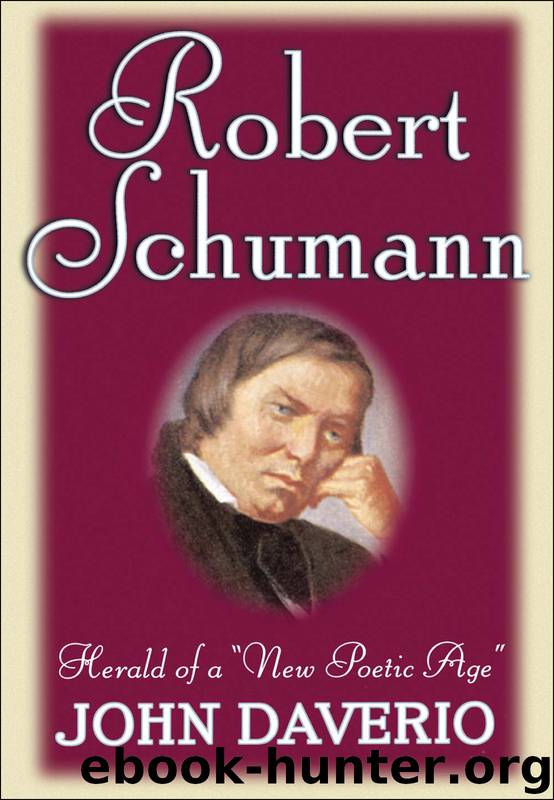Robert Schumann by Daverio John;

Author:Daverio, John;
Language: eng
Format: epub
Publisher: Oxford University Press USA - OSO
Published: 1997-03-10T16:00:00+00:00
I used to write most, practically all of my shorter pieces in [the heat of] inspiration; many compositions [were completed] with unbelievable swiftness, for instance, my First Symphony in major [was written] in four days, as was a Liederkreis of twenty pieces [Dichterliebe]; the Peri too was composed in a relatively short time. Only from the year 1845 on, when I began to invent and work out everything in my head, did a completely new manner of composing begin to develop.118
Prior to 1845, which saw the completion of a rich array of contrapuntal works, the last two movements of the Piano Concerto, and the sketches for the Second Symphony, Schumann had depended heavily on his not inconsiderable skills as an improviser at the keyboard for creative inspiration.119 In many cases, it is almost impossible to draw a firm line between pre-compositional planning (this in spite of Schumann’s practice of making continuity drafts from the First Symphony onward) and compositional elaboration: both were inextricably linked to the same process. In contrast, the “completely new manner of composing” that set in during 1845 gives primacy of place to the act of reflection, to a more sober attitude toward the business of putting notes to paper.
To be sure, Schumann’s diary entry addresses the issue of compositional process, not musical style. For Schumann, however, the “new manner of composing” did indeed result in a complex of stylistic realignments that, taken together, justify the designation of this phase of his career as the initiation of a “New Way.” Greater reflectivity in compositional planning finds a parallel in a more refined approach to the art of transition, a trait particularly in evidence in the outer movements of the Second Symphony. More important, a fanciful (sometimes hectic) play of musical affects, one of the defining characteristics of Schumann’s approach to large-scale structure during the 1830s, gives way definitively, in a work like the completed Piano Concerto, to a carefully graduated progress of moods, a feature analogous to the “alternation of tones” articulated in Hölderlin’s poetics. But most significant of all, Schumann’s compositions of 1845 speak to a profound change in his notion of what constitutes a musical idea. Simply put, the linear development of a melodic entity begins to recede in favor of a rich web of simultaneously elaborated motivic combinations. And as this process was set in motion by the products of Schumann’s contrapuntal studies in the spring and summer of 1845, it is to those works that we should now turn.
Download
This site does not store any files on its server. We only index and link to content provided by other sites. Please contact the content providers to delete copyright contents if any and email us, we'll remove relevant links or contents immediately.
| Actors & Entertainers | Artists, Architects & Photographers |
| Authors | Composers & Musicians |
| Dancers | Movie Directors |
| Television Performers | Theatre |
Cecilia; Or, Memoirs of an Heiress — Volume 3 by Fanny Burney(31449)
Cecilia; Or, Memoirs of an Heiress — Volume 2 by Fanny Burney(31401)
Fanny Burney by Claire Harman(26236)
We're Going to Need More Wine by Gabrielle Union(18625)
Plagued by Fire by Paul Hendrickson(17105)
Cat's cradle by Kurt Vonnegut(14754)
All the Missing Girls by Megan Miranda(14699)
Bombshells: Glamour Girls of a Lifetime by Sullivan Steve(13680)
Leonardo da Vinci by Walter Isaacson(12786)
4 3 2 1: A Novel by Paul Auster(11780)
For the Love of Europe by Rick Steves(11427)
Adultolescence by Gabbie Hanna(8584)
The remains of the day by Kazuo Ishiguro(8378)
Note to Self by Connor Franta(7451)
Diary of a Player by Brad Paisley(7264)
Giovanni's Room by James Baldwin(6801)
What Does This Button Do? by Bruce Dickinson(5931)
Born a Crime by Trevor Noah(5085)
The Kite Runner by Khaled Hosseini(4948)
